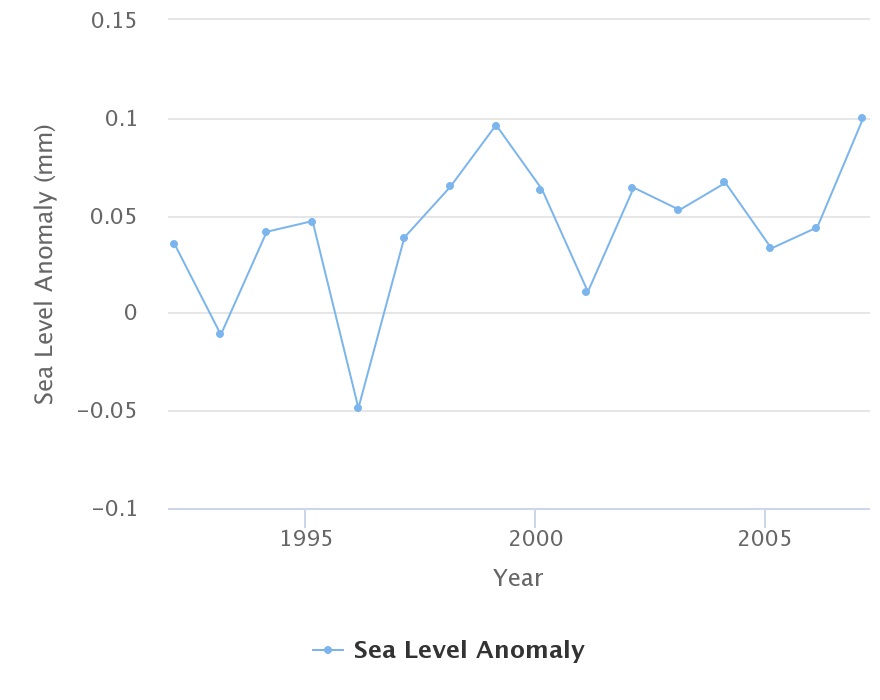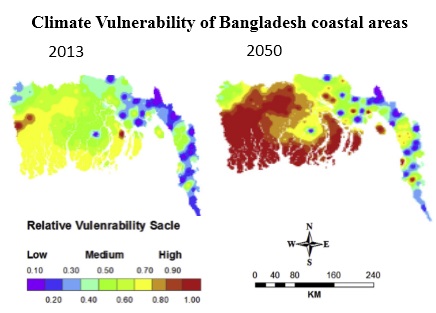Climate hazards and its Impacts
Climate hazards in Bangladesh
Coastal zone of Bangladesh is geomorphologically and hydrologically dominated by the Ganges Brahmaputra Meghna (GBM)
river system and Bay of Bengal. The central coastal zone of Bangladesh is ecologically more sensitive and
geomorphologically active. This zone is being continually attacked by cyclones, sea level rise, storm surge which have caused terrible impacts on this low lying coastal area. On the other hand, the coastal ecosystems provide a wide range of ecosystem services and benefits but this area is overpopulated and undeveloped .This study aims to identify Background of coastal risks of regional scale, rationality of coastal risks assessment, environmental impacts, risks potentials,
quantifying vulnerability, and climate change adaptation strategies.
Sea level rise
Sea level rise (SLR ) along the coastline of Bangladesh is one of the major threats which may intensify the vulnerability of global climate change . SLR will cause significant impacts on wetlands and its biodiversity; water resources; agriculture, fisheries, and aquaculture; public health; displacement and migration; displacement and migration, assets(Castro Ortiz, 1994; Kibria, 2016).A 1m rise in sea level would submerge a full 18 % of the total land area in Bangladesh(Minar et al., 2013). A research showed that deeply flooded area (depth above 100 cm, duration more than 9 months) would increase by 29% (from the base year 2000) due to 88 cm SLR by 2100(CEGIS, 2006). Salinity intrusionIncreased salinity from saltwater intrusion poses an imminent threat to livelihoods and public health through its impacts on agriculture, aquaculture, infrastructure, coastal ecosystems, and the availability of freshwater for household and commercial use(Hussain, 2008). The total amount of salinity affected land in Bangladesh was 83.3 million hectares in 1973, which had been increased up to 102 million hectares in 2000 and the amount has raised to 105.6 million hectares in 2009 and continuing to increase(Mahmuduzzaman, Ahmed, Nuruzzaman, & Ahmed, 2014). With the increasing impacts of climate change, salinity intrusion gradually is going towards inland water. Coastal flooding
Coastal flood can be caused by tropical cyclone and tsunami(UNDRO., 1980) .the intensity of coastal flooding depends on height of SLR , tidal level and storm surge . Bangladesh is one of the most flood prone countries in the world due to its unique geographical location, topography and exposure to tropical cyclones. With 50% of the land less than 8 meters above sea level, and a coastline of some 600 km, coastal flooding is a common problem(“Bangladesh – Coastal Flooding Forecasts Save Lives – FloodList,” 2017).
Cyclones Cyclone causes significant loss of lives and damage to properties, coastal infrastructures, ecosystems, and economy of Bangladesh. Coastal zone is subject to disastrous cyclone almost every years .Bangladesh is especially vulnerable to tropical cyclones with around 718,000 deaths from them in the past 50 years (Ubydul Haque, Masahiro Hashizume, Korine N Kolivras, Hans J Overgaard, Bivash Das, 2012).The Bay of Bengal is vulnerable to cyclones predominantly in the pre-monsoon months of April-May and the post-monsoon months of October- December (Sarker, 2018). A study predicted intensified tropical cyclones and associated storm surges with an increase in Sea surface temperature(Emanuel, 2005) . .



